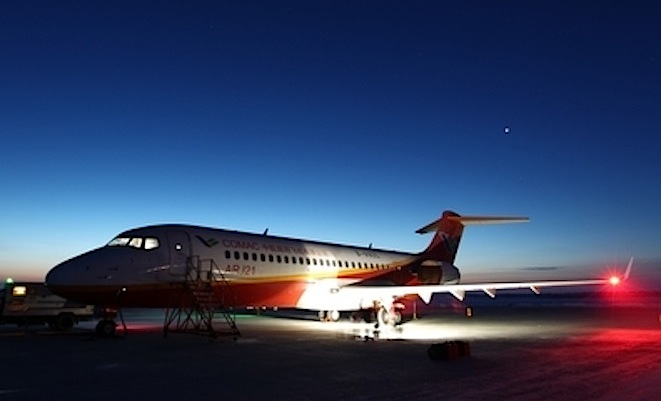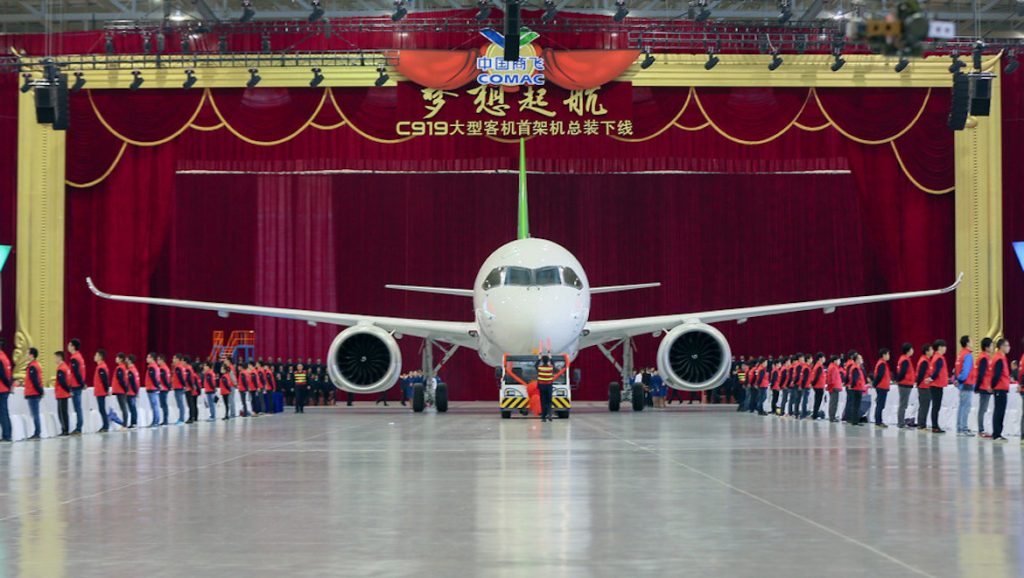
The ending of joint venture talks between Boeing and Embraer over the acquisition of the Brazilian airframer’s commercial aircraft division has triggered speculations over a potential COMAC-Embraer partnership.
Despite appearing in theory like a perfect match, a substitution of Boeing by COMAC (Commercial Aircraft Corporation of China), the Chinese firm in charge of airliner development, has very little chance of becoming a reality for a variety of operational reasons.
At first glance, the very idea of China stepping up and injecting money into Embraer makes perfect sense. Boeing initiated acquisition talks with Embraer as a reaction to rival Airbus buying Bombardier’s C-Series program (since then rebranded A220) in 2018. Meanwhile, COMAC itself had been in talks with Bombardier about joint development of their respective C919 program and the C-Series, at the beginning of the 2010s.
Therefore, an exit Boeing / enter COMAC scenario may appear perfectly logical and fitting neatly within the frame of BRICS (Brazil, Russia, India, China, South Africa) co-operation, a framework still favoured by some (for sure, not all) governmental circles in Brazil.
But considering past experiences, many reasons make this prospective alliance highly unlikely, barring a surprising political choice being imposed on COMAC by China’s central government. Embraer certainly does not seem to share the enthusiasm expressed in some government circles, for the simple reason that the Brazilian planemaker already has a bitter and revealing experience of the Chinese market.
In 2003, Embraer opened in the northern Chinese province of Heilongjiang a joint venture with AVIC (Aviation Industry Corporation of China), a conglomerate from which COMAC would be born three years later and its main supplier since. Dedicated to the assembly of the ERJ145 model (which would become the Brazilian planemaker’s first major commercial aviation success), the rationale behind the Chinese plant was supported by the attractive perspectives of air transport development in China.
But in 2010, the Harbin Embraer venture stopped assembly of ERJ145s after selling only 40 units over a seven-year period – far from the initial expectations. And, after a failed attempt at producing business jets, the joint venture was dissolved in 2016.
The ARJ21 factor
The (untold) reason for the failure of Embraer’s joint venture in China was the emergence of COMAC’s own first program: the ARJ21. Inherited from AVIC, the ARJ21 regional jet first flew in 2008 and was then expected to be quickly sold to Chinese airlines. Although the ERJ145 is much smaller than the ARJ21 (seating 50 passengers, against 78 for the typical configuration of COMAC’s model), its massive irruption in Chinese airlines fleets – just as it had done some years before in US regional airlines fleets – would have seriously jeopardised growth perspectives on the domestic market for COMAC’s ARJ21.
The main hurdle for prospective co-operation is that 12 years on, the ARJ21 factor is still very much part of the equation. COMAC’s pioneer program had a protracted development, so much so that it is today still in its early commercial deployment phase. And to make things worse, a tie-up with the Brazilian planemaker would now imply opening the Chinese market to a very direct competitor.
Whereas several Chinese airlines have integrated the larger E190 into their fleet (with about 100 of those flying in China today), Embraer’s E175 model has been kept out of the domestic market. With 76 seats in a typical configuration, the E175 is positioned in precisely the same segment as the ARJ21.
Introduction on the Chinese market of a competing model that benefits from the operational experience of having over 600 units flying worldwide would deal a fatal blow to COMAC’s pioneer program, which still has only 24 units in operation with three Chinese airlines.

The C919 factor
An additional factor in the equation, and probably the main argument for cooperation with Embraer, is COMAC’s other major program: the C919 medium-haul airliner. The rationale is that, just as COMAC tried to benefit from technological co-operation with Canada’s Bombardier in the 2010s, the Chinese planemaker could benefit from Embraer’s know-how to speed up the development of its major program, still currently facing many technical difficulties in the race towards official certification.
But from the older interest in Bombardier to the current speculation over an alliance with Embraer, scenarios are very different indeed. If COMAC ever considered buying the financially distressed commercial aviation branch of Bombardier (and it probably did), it was at a time when the Canadian planemaker’s C-Series program was still under development, thus not yet operating with airlines.
The rationale behind such an operation would have been integrating C-Series technologies into the C919 program, and then killing the Canadian program to avoid “cannibalism” with the C919. Such a scenario is inconceivable with the latest family of airliners developed by Embraer. With its largest version, the E195-E2, coming dangerously close to what could be a future shortened version of the C919 (the E195-E2 typically seats 132 passengers, versus 168 for the C919), the E2 family has begun commercial service in 2018.
It would be inconceivable for Embraer to retire this model, as much as it would make no sense for COMAC to finance it, whereas its own C919 could be certified in 2021 in the best-case scenario.
To put things bluntly, and in a way that does not fit with official BRICS co-operation narrative, the best COMAC could expect from Embraer is the disappearing of a competitor taking a strong foothold in markets – including Africa – where the Chinese planemaker expects to make its global debuts. Not the best of premises for an alliance…
In a way, such a motivation for an acquisition would be nothing new, as illustrated by the recently confirmed takeover of Bombardier’s Canadair Regional Jet – CRJ program by Mitsubishi Heavy Industries – MHI, to be concluded on 1 June. The takeover very transparently includes the eventual ending of the CRJ program to clear the path for MHI’s Spacejet regional airliner. This strategy of “cannibalisation” of the target’s product line was also part of the outcome of the McDonnell Douglas takeover by Boeing in 1997.
But, to put things even more bluntly, it now appears unlikely that COMAC would put US$4 billion (the price tag evoked in talks between Boeing and Embraer) on the table, to achieve a result that may be reached naturally thanks to the current global market turmoil.
Unless Beijing believes that creating a rift between Brasilia and Washington is worth the risk and imposes this strategy on COMAC, chances that the Chinese planemaker will move in and rescue Embraer appear slim, if not downright inexistent. And putting at risk leading national airliners’ programs, which sit at the very center of the nation’s efforts towards industrial upgrading and eventual independence (in the spirit of the Made in China 2025 program), would be a very surprising move by the Chinese government.










